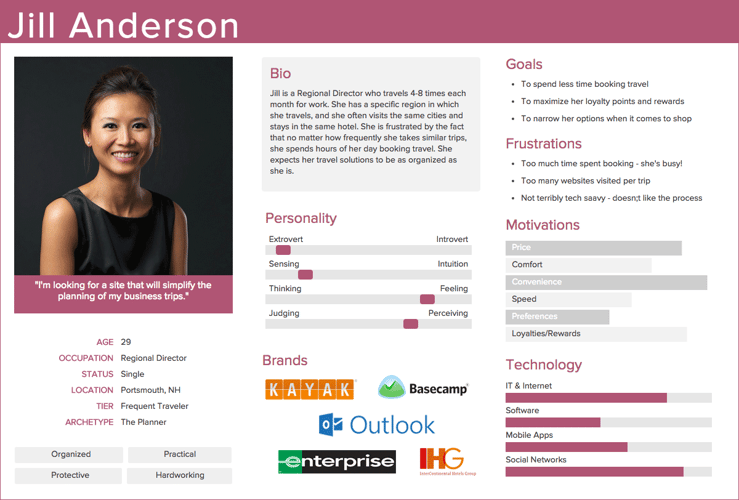 One key to business success is a deep understanding of who your clients are. Knowing your clients’ needs, wants, and frustrations helps you shape your business to best serve them and increase revenue. Understanding your current clients also helps you attract new ones.
One key to business success is a deep understanding of who your clients are. Knowing your clients’ needs, wants, and frustrations helps you shape your business to best serve them and increase revenue. Understanding your current clients also helps you attract new ones.
You’ll most likely never know each of your clients on a deeply personal level. That’s why you create client personas. They help aggregate information about your clients into one, tangible profile so you can make smart, client-focused decisions that set your business up for growth.
What are client personas?
Client personas are a realistic representation of your actual clients. Depending on how you segment your clients–group them by some variable such as age, marital status, gender, etc.–you might have one client persona or several. There is no perfect number of personas to have; Just be careful not to make so many that your business goals become unfocused.
Personas help you focus on your clients when making business decisions. Because so much research goes into creating personas, they act as a realistic representation of the segment you are considering. This allows you to consider how your real clients might react to a change in the business.
Personas are built through client observation and research. As you’ll see in the sections below, it’s much more than just using what you think you know about your clients. But it’s worth the effort. Strong client personas help you and your staff mold your business and communications to create the best possible client experience and maximize revenue.
Client observation
If you aren’t already doing this on some level at your small business, you should be. Client observation is the act of observing your clients at your business without them knowing you’re doing so (but not in a creepy way). The point is to minimize bias to understand how your clients naturally act and think.
How to effectively observe clients
First determine what you are going to observe your clients doing. Checking into classes at your business? Interacting with instructors? Signing waivers? This will help you decide where you’re going to go and what you’re going to pay attention to.
Select an inconspicuous spot that is close enough to observe your clients, but removed enough that you won’t become a distraction. This is important, since people tend to change their behavior when they know they’re being watched.
Then, watch your clients doing the thing you’ve decided to watch. Make note of what works well, and what causes frustration. There is no set amount of time you should do this for, so just keep watching until you feel like you have a good idea of what is going on.
Watching your clients interact with your business may expose points of frustration that you weren’t aware of before. Fix these friction points to improve your client experience. Your current clients will be happy, and prospective clients will be more attracted to your business.
Client research
They type of research I’m referring to here follows more of a system than general observation. These client studies may include demographic research, interviews, focus groups, client surveys, or something else entirely. Whichever method you use, the goal is to expose behavioral patterns that add to your knowledge of who your clients are.
Why does this matter? Because actually looking at what your clients say or do shows you how they act in the real world, without bias. It makes personas more authentic and more accurate.
How to do client research
Client studies can range from a simple conversation with a client to a complex and large-scale study. The first thing you need to figure out what is doable for you and your business.
Design your study around your business needs. But no matter the size of your study, you’ll be following these five steps:
- Define your goals and your users
- Decide how you’ll be running your study
- Prepare your questions ahead of time
- Collect and organize your data
- Analyze your data
Client behaviors and preferences regularly shift, so make sure you conduct regular research. At the conclusion of each study, you should know a lot more about who your clients are, how they think, and what they want.
Putting it all together
Once you’ve gathered all of your information, it’s time to combine it in a way that makes it useful for you. Did you notice any trends or patterns? Did anything stand out to you? Did anything surprise you?
Take your data and use it to create an invented person (or persons). Give your persona a name and talk about them in the third person as if they were real. If you think a photo would help make the persona more real, include one. While you should focus on the traits that are most important to your business, common ones you might give them include:
- Name + photo
- Demographics (age, income, etc.)
- Location
- Occupation
- Interests + hobbies
Go into detail. Maybe it seems cheesy, but personas only work if they are built as realistically as possible. That way, when you weigh business decisions against how your persona might react, you know that you’re using an accurate representation of your actual clients.
Below is an example of a persona from KeepItUsable (follow this link to see more). Your persona may not look like this, but it should strive for a similar level of detail.

Keep your knowledge current
You probably already spend a lot of time around your clients. Use this time to talk to them and get frequent feedback about your business. This is easy to do as part of your regular day, and there is no such thing as too much information about how your clients feel about you.
But while casual conversations are important, it’s equally important to regularly approach client research more systematically. The needs and preferences of clients regularly evolve, and your business can keep up with these shifts by always being informed.